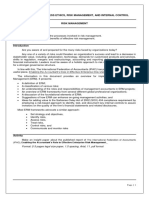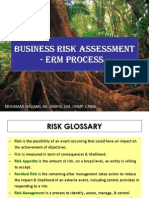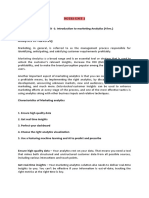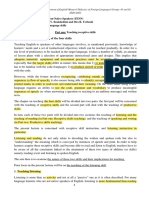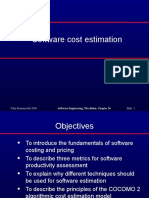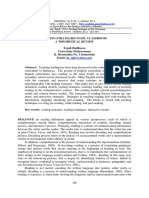Risk Appetite - How Hungry Are You?: by by Richard Barfield
Risk Appetite - How Hungry Are You?: by by Richard Barfield
Uploaded by
NczthCopyright:
Available Formats
Risk Appetite - How Hungry Are You?: by by Richard Barfield
Risk Appetite - How Hungry Are You?: by by Richard Barfield
Uploaded by
NczthOriginal Description:
Original Title
Copyright
Available Formats
Share this document
Did you find this document useful?
Is this content inappropriate?
Copyright:
Available Formats
Risk Appetite - How Hungry Are You?: by by Richard Barfield
Risk Appetite - How Hungry Are You?: by by Richard Barfield
Uploaded by
NczthCopyright:
Available Formats
Risk appetite – How hungry are you?
by Richard Barfield
the journal • Special risk management edition
Richard Barfield
Director, Valuation & Strategy, UK
Tel: 44 20 7804 6658
Email: richard.barfield@uk.pwc.com
Regulatory pressures, such as Basel II investors’ appetite for risk will differ • The basis for consistent communication
and a greater focus on corporate from that of the rating agencies. Equity to different stakeholders; and
governance, have been a stimulus investors want to see a return; rating
for many changes in the industry – agencies want to minimise risk of default. • Explicit articulation of the attitudes
one of these has been the recognition The regulator’s perspective differs from to risk of the senior management.
of the need to articulate risk appetite management’s which differs from that
more clearly. On the face of it, this may As CROs play a fuller role at board level1,
of customers, employees, bondholders
seem easy to do. After all, is it not simply initiating a risk appetite discussion can be
etc. Consequently, articulating risk
a combination of an institution’s desired an ideal way to engage senior colleagues
appetite is a complex task which requires
credit rating, regulatory capital structure ˆ and the board on risk issues and strategy.
the balancing of many views. Some
and the relevant solvency needs which
elements can be quantified but ultimately In our experience, a top-down approach
set the ability of the institution to
it is a question of judgement. All too is usually the best way to begin to tackle
withstand shocks and therefore represent
often many parties take false comfort the problem of defining risk appetite.
its risk appetite? For some smaller firms
from purely quantitative risk measures A top-down approach makes the
this approach may well be enough, but for
which, if they were actually attained, would requirements of the various external
others risk appetite is a more complicated
in practice result in huge reputational stakeholders explicit and stimulates
affair at the heart of risk management
damage and job losses for the CEO and debate in the executive team. The process
strategy and indeed the business strategy.
the chief risk officer (CRO). can also be used to engage board and
Defined well, risk appetite translates non-executive directors on the subject.
risk metrics and methods into business Benefits to the organisation The result is a robust framework that can
decisions, reporting and day-to-day and the CRO be used to articulate appetite throughout
business discussions. It sets the the group and to external stakeholders.
boundaries which form a dynamic There are considerable benefits in
link between strategy, target setting taking the time to articulate risk Figure 1 (overleaf) conveys an overall
and risk management. appetite properly. If a financial institution approach which involves assessing
(or indeed any corporate) has arrived risk appetite from different stakeholder
Risk appetite is of course in the eye of at a crisp definition of its risk appetite perspectives and risk types. The top-
the beholder (if the reader will excuse a it will have achieved: down view of risk appetite leads typically
mixed metaphor!). Different parts of the into an assessment of the desired risk-
organisation and external stakeholders • Clarity over the risks that the profile and an action plan to achieve it.
have different perspectives. Equity organisation wishes to assume; PricewaterhouseCoopers has developed
1 See for example the PricewaterhouseCoopers/EIU briefing: ‘Uncertainty tamed? The evolution of risk management in the financial services industry’
the journal • Special risk management edition
Risk appetite – How hungry are you?
10
a number of tools and concepts to help often a passive description of risk a compliance issue to be monitored by
clients cut through the complexities of appetite today rather than a proactive internal audit.
this multi-dimensional problem. For view of where management wants to take
example, we have found it helpful to the organisation. Another benefit of the Risk, return and reputation
introduce the concept of risk capacity. top-down approach is that it ensures
An organisation’s risk capacity is the that senior management are ‘on the It is also important to look at other
maximum amount of risk that it can same page’ on risk appetite. This may aspects of risk. For example, it is
assume. This is an important concept require more investment at the start but essential to discuss risk in the context
because risk appetite must be set at a it pays dividends by making subsequent of a company’s desired levels of return
level within the capacity limit. Capacity roll-out much easier. and growth. At corporate level in a
needs to be considered before appetite. quoted company this might involve a
Stakeholder views will differ on the At one client the first appointee to the Total Shareholder Return (TSR) target.
desired safety margin and it is crucial newly created role of CRO has used Many companies set targets for these
to understand this in setting and risk appetite discussions to engage the and publicise them – usually in terms
understanding appetite. It is also business unit heads in defining the links of outperforming a peer group. If we turn
necessary to assess other factors such between risk and strategy. This is the first this around and look at it from the risk
as the potential impact of a risk incident, time that risk has been considered as perspective, it could be interpreted that
as well as the ability of the organisation an integral part of the business agenda. management wishes to outperform its
to control the activity and the market’s Previously risk was treated primarily as peers in assuming risk! We have yet
perception of the ‘fit’ with the institution’s
other activities. These qualitative factors, Figure 1: Approach to risk appetite
when combined with risk capacity and
risk measures, enable a balanced
appetite to be articulated and monitored.
Risk appetite: the quantum of risk that
the firm is willing to accept within
A top-down approach works better Risk Appetite
its overall capacity
than a detailed bottom-up assessment.
The reason for this is that it is really the
Risk capacity: the maximum risk that the
only way to bring in the views of external Risk Capacity firm can bear which is linked to capital,
stakeholders and to create a proactive liquid assets, borrowing capacity etc
Target Risk Profile
Risk profile: target profile represents
statement of what management believes the allocation of appetite to risk
Actual Risk Profile
its risk appetite should be. In our categories. Actual profile represents
risks that are currently assumed
experience, bottom-up approaches BR CR MR OR LR
OR GR
Risk categories: tailored
tend to endorse the status quo and Business Credit Market Operational Liquidity Group for the business
the existing risk profile. They do not
take the thinking forward. The result is Source: PricewaterhouseCoopers
the journal • Special risk management edition
11
to see a company set risk-adjusted Without a top-down perspective, consumer lending might be quite
TSR targets. such risks can be missed. different to its appetite for market risk
in its investment banking operation.
If management, however, is clear about It is essential to take a multi-dimensional Management’s appetite for risk will differ
its risk appetite and develops a core and balanced view of risk appetite and in a start-up operation in a new market
competence in risk management it periodically to refresh it. Admittedly this compared to maintaining an established
should, everything else being equal, can be difficult, as it is often very hard for business in a mature market – and so on.
management to be objective about how
be able to deliver superior returns to its
others see the institution. A major benefit of defining risk appetite
shareholders. Similar arguments apply
is that it forces the debate and helps
to unquoted companies such as mutual
Risk appetite and culture ensure that risks are made explicit.
institutions and cooperative banks. By
To change behaviours in relation to risk,
building a risk management competence, One of the more interesting internal interventions through additional training
returns to members should improve. challenges in financial services or changing personnel may be needed,
organisations, which often tend to but in most organisations the tone set by
Hunger for returns without a defined be risk averse and conservative, is to senior management tends to have by far
appetite for risk can lead to disaster. ensure that business unit management the greatest impact.
Many apparent risk management is assuming sufficient risk! Retail banks
failures have been caused by profits in mature markets must rise to this The role of economic capital
being chased and risks being assumed challenge as they strive to find new
that were poorly understood. Often growth opportunities. Incumbent From a group perspective, risk appetite
management makes the mistake of management teams, who are often is an important input to determining
focusing on the appetite of one group very good at maintaining the existing economic capital which, in turn, influences
machine, find they need new skills overall capital requirements. Economic
of stakeholders without giving sufficient
to tune up the engine and go faster. capital usually has a key role to play
weight to the appetites of others.
Without a change in risk appetite, in the quantification of risk and in
Experience shows that reputation can these companies can find themselves embedding risk appetite in the
underperforming in terms of returns. operational infrastructure of the business.
be damaged even if the firm survives.
These methodologies give business
Sometimes severe reputational damage
Culture, strategy, and competitive management a tool to quantify risk and
can be caused by an incident in one position all influence risk appetite. to understand much better the
part of the group leading to contagion Different firms will have different relationship between risk and return.
and damage elsewhere. This can be tolerances for different risk types.
particularly acute in financial institutions Furthermore, within a firm, appetite There are justifiable concerns, however,
which require the trust of their depositors should differ between business units. about relying entirely on bottom-up
or policyholders to remain solvent. A bank’s appetite for credit risk in economic capital models.
the journal • Special risk management edition
Risk appetite – How hungry are you?
12
Management needs a top-down view as
Figure 2: Risk appetite
a cross-check. For example, the problems
encountered measuring diversification
benefits or determining capital Quantitative measures • Hard measures of risk
requirements for ‘difficult to quantify’ • Describe the type and quantum of risk the business
risks such as strategic risk mean that wants to and is willing to take
bottom-up views may not reflect the • Relate directly to business plans and risk measurement
processes
true position. Indeed many companies
• E.g. appetite for earnings volatility
face major difficulties in quantifying the
capital associated with operational risk. Qualitative measures • Recognise that not all risk is measurable but can affect
business performance
• E.g. appetite for business activities outside core
A top-down view of risk appetite
competencies
informs a top-down view of capital
Zero tolerance risks • A subset of the above - identify the categories of risk we
requirements. The imminent arrival
wish to avoid
of Pillar 2 means that some banks
• E.g. appetite for regulatory mis-compliance
are developing such a view for the
first time. Without a clear position, Source: PricewaterhouseCoopers
an institution is likely to be at
a disadvantage with its supervisor.
appetite for them. This needs to be done Establishing a clearer statement of risk
‘Difficult to quantify’ risks in a comprehensive and balanced way appetite has important consequences in
where quantitative measures are terms of management information and
Naturally enough, if some elements combined with qualitative measures, performance management requirements.
of risk appetite cannot be measured as well as those for which the institution There are also likely to be implications
they could be more difficult to manage. may have zero tolerance. These three for risk assessment, measurement and
Examples might include business key components of a group-level risk reporting. New management information
risk or reputational risk. Arguably appetite definition are shown in Figure 2. may be required to monitor risks and the
these are the risks that can benefit consumption of appetite across a group.
most from being articulated more Linking risk appetite In some cases, this will involve new cuts
clearly, even if it is in qualitative terms. to the business on existing data; in others it will require
Nevertheless, quantitative techniques new information feeds (which could be
are improving all the time. To embed risk appetite effectively as straightforward as monitoring certain
in the business requires management risk concentrations on a group-wide basis).
The implication for management is clear: to establish limits for each risk type In most cases, it will require harmonisation
identify the risks that the organisation and cascade them to lower levels of existing limit structures and clarification
faces, measure them and articulate the in the organisation. of roles and responsibilities.
the journal • Special risk management edition
13
A critical issue is to gather sufficient • Can you describe the appetites of
leading indicator data that allows all of your main stakeholder groups:
management to take pre-emptive supervisor, rating agencies, investors
action before appetite is exceeded and customers?
or limits are breached. It is of little
value to report passively at the end • Can you populate Figure 2 with
of the month that appetite has been the key metrics and values for
exceeded. It is of greater value to your organisation?
take preventive action. Provided the
information is available, management If the answer to any of these questions
will have a range of options to is ‘no’, the chances are that your
choose from. These might include firm could benefit from re-defining
risk transfer (for example, the its risk appetite.
use of derivatives and swaps);
Risk is good but it needs to be
unwinding of positions; deceleration
understood. That understanding
of growth etc.
begins with the board and senior
Furthermore, risk information needs management. Risk appetite definition
to be interpreted dynamically. is often the first step to deepening
As credit risk exposures increase, and broadening that understanding
appetite for market risk may decrease. and shaping risk management strategy.
The degree of flexibility granted to
particular managers to adjust the dials
on the risk management dashboard,
however, will clearly depend on the
firm’s risk governance approach.
Do you need to take action?
Ask yourself three questions to see if you
need to take action:
• Has your senior team recently
debated its view of the organisation’s
risk appetite?
the journal • Special risk management edition
You might also like
- A Buyer's Life: A Concise Guide To Retail Planning and ForecastingDocument35 pagesA Buyer's Life: A Concise Guide To Retail Planning and Forecastingfairchildbooks53% (15)
- Radical ReportingDocument254 pagesRadical ReportinganonymNo ratings yet
- Utmb Third Party Risk Management ReportDocument7 pagesUtmb Third Party Risk Management ReportEqbal GubranNo ratings yet
- CQU Risk Appetite StatementDocument3 pagesCQU Risk Appetite Statementleonciong67% (3)
- Grifindo Toys DocumentDocument45 pagesGrifindo Toys DocumentC. Grinath100% (1)
- Complex Systems Design Management 2019 PDFDocument257 pagesComplex Systems Design Management 2019 PDFDerg Guzm100% (1)
- Internal Audit - Mindmap - Margareta Lillian L ADocument7 pagesInternal Audit - Mindmap - Margareta Lillian L AMargareta LilianNo ratings yet
- Quest Diagnostics (A) : Improving Performance at The Call CentersDocument8 pagesQuest Diagnostics (A) : Improving Performance at The Call CentersShruti Paradarshi MishraNo ratings yet
- ERM CharterDocument3 pagesERM ChartertitooluwaNo ratings yet
- RISK-ACADEMY - Risk Management RoadmapDocument1 pageRISK-ACADEMY - Risk Management RoadmapcezarzanioloNo ratings yet
- Operational Risk Management Plan A Complete Guide - 2020 EditionFrom EverandOperational Risk Management Plan A Complete Guide - 2020 EditionNo ratings yet
- ISO 31000 Risk Management Best Practice A Complete Guide - 2020 EditionFrom EverandISO 31000 Risk Management Best Practice A Complete Guide - 2020 EditionNo ratings yet
- Third Party Risk Management Framework A Complete Guide - 2021 EditionFrom EverandThird Party Risk Management Framework A Complete Guide - 2021 EditionNo ratings yet
- Change Management Theories and Strategies: Dr. Tam Weng Wah INTAN, Bukit KiaraDocument42 pagesChange Management Theories and Strategies: Dr. Tam Weng Wah INTAN, Bukit KiaraMohd Azmi Arifin100% (1)
- Apigee: People Management Practices and The Challenge of GrowthDocument2 pagesApigee: People Management Practices and The Challenge of GrowthHarsh AgrawalNo ratings yet
- Operational RiskDocument6 pagesOperational Riskaichaanalyst4456No ratings yet
- Risk Reporting & Key Risk Indicators: A Case Study AnalysisDocument34 pagesRisk Reporting & Key Risk Indicators: A Case Study AnalysisAjaz Memon100% (1)
- Global Enterprise Risk Management Foundation ExamDocument12 pagesGlobal Enterprise Risk Management Foundation ExamIRM India100% (1)
- Fundamentals of Enterprise Risk Management Level 1Document12 pagesFundamentals of Enterprise Risk Management Level 1IRM IndiaNo ratings yet
- Strategic RiskDocument18 pagesStrategic RiskJonisha JonesNo ratings yet
- Risk Management ReportDocument9 pagesRisk Management Reportkhaoula lahciniNo ratings yet
- Risk Management StrategiesDocument12 pagesRisk Management StrategiesLudwig GeoffreyNo ratings yet
- Module III. Risk ManagementDocument5 pagesModule III. Risk ManagementMelanie SamsonaNo ratings yet
- Project Risk Management: Compiled by Muhammad Aleem Habib June 25, 2013 Information Derived From PMBOK & Rita MulcahyDocument115 pagesProject Risk Management: Compiled by Muhammad Aleem Habib June 25, 2013 Information Derived From PMBOK & Rita MulcahyshajiahNo ratings yet
- Abstract. The Main Objective of The Paper Is To Discuss How IndicatorsDocument14 pagesAbstract. The Main Objective of The Paper Is To Discuss How IndicatorsEddy Edwin WNo ratings yet
- VIU Risk Management FrameworkDocument9 pagesVIU Risk Management FrameworkkharistiaNo ratings yet
- Operational Risk Management Framework and Control Self AssessmentDocument51 pagesOperational Risk Management Framework and Control Self AssessmentTejendrasinh GohilNo ratings yet
- Risk Rating Matrix: Low Medium Medium HighDocument3 pagesRisk Rating Matrix: Low Medium Medium HighTharaka Samarasekara100% (1)
- What Is A Risk Assessment - Definition FromDocument3 pagesWhat Is A Risk Assessment - Definition FromJaveed A. KhanNo ratings yet
- Strategic Risk Register PDF 1660418288Document25 pagesStrategic Risk Register PDF 1660418288mohamedNo ratings yet
- Governance and Risk ManagementDocument41 pagesGovernance and Risk Managementshb.sajjadhaiderNo ratings yet
- Core Risk Management Policy enDocument13 pagesCore Risk Management Policy enJaveed A. KhanNo ratings yet
- Internal Control System (Cont.)Document5 pagesInternal Control System (Cont.)Lorence IbañezNo ratings yet
- Capability Maturity ModelDocument4 pagesCapability Maturity Modelfungas123No ratings yet
- IIA POSITION PAPER The Role of Internal Auditing in Enterprise Risk ManagementDocument8 pagesIIA POSITION PAPER The Role of Internal Auditing in Enterprise Risk ManagementDennis GivariNo ratings yet
- Business Risk Assessment - ERM ProcessDocument26 pagesBusiness Risk Assessment - ERM ProcesscarwadevilisbackNo ratings yet
- Breaking Down ISO 31000:2018Document5 pagesBreaking Down ISO 31000:2018Amit PaulNo ratings yet
- Mastering Risk AssessmentDocument13 pagesMastering Risk AssessmentKalangi RadhaKrishna RaoNo ratings yet
- All ITTO For Risk ManagementDocument1 pageAll ITTO For Risk ManagementSohaib Omer SalihNo ratings yet
- ERM Training Day 1Document33 pagesERM Training Day 1leonciong100% (1)
- Chief Risk Officer Job Description Sample 3Document2 pagesChief Risk Officer Job Description Sample 3ozlemNo ratings yet
- Risk ManagementDocument25 pagesRisk ManagementCanlas John MichaelNo ratings yet
- DTTL Legal Legal Risk ManagementDocument19 pagesDTTL Legal Legal Risk ManagementArturo EstradaNo ratings yet
- 2020 08 Risk Management Framework PolicyDocument33 pages2020 08 Risk Management Framework PolicySk Islam100% (1)
- Operational Risk: An Overview: Dr. Richa Verma BajajDocument37 pagesOperational Risk: An Overview: Dr. Richa Verma BajajJoydeep Dutta100% (1)
- 04RM - Risk-Assessment 2Document32 pages04RM - Risk-Assessment 2Darren TanNo ratings yet
- Case Study Operational RiskDocument27 pagesCase Study Operational RiskDikankatla SelahleNo ratings yet
- Lecture 7 - Internal Control and Control RiskDocument38 pagesLecture 7 - Internal Control and Control RiskZale EzekielNo ratings yet
- GRC Reference Architecture - Role - Process Specific ApplicationsDocument4 pagesGRC Reference Architecture - Role - Process Specific ApplicationsAdriano SaadNo ratings yet
- Risk Management Contents Table FormatDocument9 pagesRisk Management Contents Table FormatAnushka Gandhi100% (1)
- Risk Management in BankingDocument56 pagesRisk Management in Bankingthulli06No ratings yet
- Risk Management in The Oil and Gas Industry-LevsonDocument10 pagesRisk Management in The Oil and Gas Industry-LevsonlizuttNo ratings yet
- Cost, Benefit & Risk Assessment For OutsourcingDocument18 pagesCost, Benefit & Risk Assessment For OutsourcingkritikandhariNo ratings yet
- 4 - COSO ERM and More - Protiviti - Bob HirthDocument70 pages4 - COSO ERM and More - Protiviti - Bob HirthRena Rose MalunesNo ratings yet
- Gap AssessmentDocument8 pagesGap AssessmentAbdo CasaNo ratings yet
- 11 - Project Risk ManagementDocument32 pages11 - Project Risk ManagementRobbyFirzaNo ratings yet
- Compliance Risks and Controls: Speaker: Dott. Fabio AccardiDocument14 pagesCompliance Risks and Controls: Speaker: Dott. Fabio AccardiJefferson Widodo100% (1)
- A Risk Management Standard (AIRMIC IRM 2002)Document17 pagesA Risk Management Standard (AIRMIC IRM 2002)ducuhNo ratings yet
- Business Continuity Plan Administrator Complete Self-Assessment GuideFrom EverandBusiness Continuity Plan Administrator Complete Self-Assessment GuideNo ratings yet
- Business Continuity Strategy Complete Self-Assessment GuideFrom EverandBusiness Continuity Strategy Complete Self-Assessment GuideNo ratings yet
- Institutional Ownership and Agency Conflict Controlling MechanismDocument18 pagesInstitutional Ownership and Agency Conflict Controlling MechanismNczthNo ratings yet
- New Wave Marketing Consumer BehaviorDocument2 pagesNew Wave Marketing Consumer BehaviorNczthNo ratings yet
- WestPacific ICD-10 26AUG15v3Document2 pagesWestPacific ICD-10 26AUG15v3NczthNo ratings yet
- Wa0033Document16 pagesWa0033NczthNo ratings yet
- High Point 3 TBDocument146 pagesHigh Point 3 TBGUADALUPENo ratings yet
- Language Into Flow - A Tbilisi ExperimentDocument25 pagesLanguage Into Flow - A Tbilisi ExperimentMartin Francis Moverley SmithNo ratings yet
- SAP Fund ManagementDocument4 pagesSAP Fund Managementmalik_naseerullah100% (1)
- Novartis BSM LeanLabDesignWorkshopWhitePaper PDFDocument35 pagesNovartis BSM LeanLabDesignWorkshopWhitePaper PDFReman A YehyaNo ratings yet
- Autopoiesis and Cognition: Paul Bourgine, CREA-Ecole PolytechniqueDocument2 pagesAutopoiesis and Cognition: Paul Bourgine, CREA-Ecole Polytechniqueparents021No ratings yet
- Intertextual IntrusionsDocument5 pagesIntertextual IntrusionsAna Clara ValdezNo ratings yet
- SIDOPSDocument6 pagesSIDOPSmameuriNo ratings yet
- Technology RoadmapDocument13 pagesTechnology RoadmaptgrclarkeNo ratings yet
- Created Module in Teaching ListeningDocument15 pagesCreated Module in Teaching ListeningAnjenith OlleresNo ratings yet
- Unit 1,2,3,4,5 MaDocument97 pagesUnit 1,2,3,4,5 MaPRADYUMN KUMAR DUBEYNo ratings yet
- YashwanthDocument98 pagesYashwanthChaitu KumariNo ratings yet
- Instituto Superior Técnico Universidade de Lisboa: Flexibility: Origins, Definitions and Similar TermsDocument34 pagesInstituto Superior Técnico Universidade de Lisboa: Flexibility: Origins, Definitions and Similar TermsmutiaraNo ratings yet
- Documenting The Interactive Effects of Project Manager and Team-Level Communication Behaviors in Integrated Project Delivery TeamsDocument16 pagesDocumenting The Interactive Effects of Project Manager and Team-Level Communication Behaviors in Integrated Project Delivery Teamstimaria68No ratings yet
- Wollo College of Informatics: UniversityDocument38 pagesWollo College of Informatics: UniversityMinte DejeneNo ratings yet
- Project ManagementDocument23 pagesProject Managementmanoj22490No ratings yet
- Agile Transformation at LEGO Group: Research-Technology ManagementDocument11 pagesAgile Transformation at LEGO Group: Research-Technology Managementengineer watchnutNo ratings yet
- Chapter 8 PerceptionDocument29 pagesChapter 8 PerceptionSanjana VegesnaNo ratings yet
- Theories of The Reading ProcessDocument11 pagesTheories of The Reading Processjernalynluzano50% (2)
- TENN S1 Lecture 04 Teaching ListeningDocument7 pagesTENN S1 Lecture 04 Teaching ListeningthusneldachanNo ratings yet
- Observation Report: TESOL Certificate ProgramsDocument3 pagesObservation Report: TESOL Certificate Programsapi-291611819No ratings yet
- Software Cost EstimationDocument58 pagesSoftware Cost EstimationMmNo ratings yet
- AtensiDocument23 pagesAtensiAsina ChristinaNo ratings yet
- EP0503 - 4. Fleet PlanningDocument19 pagesEP0503 - 4. Fleet PlanningJackLiewNo ratings yet
- Re-Promoting Weakening Local Values To Manage Spermonde Marine Resources: An Insight From Compromise To Co-ExistenceDocument16 pagesRe-Promoting Weakening Local Values To Manage Spermonde Marine Resources: An Insight From Compromise To Co-ExistenceNajman MasagalaNo ratings yet
- Reading Strategies in Efl Classroom A TheoreticalDocument16 pagesReading Strategies in Efl Classroom A Theoreticalnur anisaNo ratings yet






















